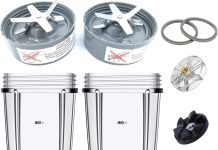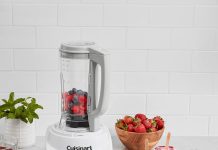Let us take a moment to explore an age-old question – can blenders be used to grind coffee beans? We have all found ourselves in that morning rush, desperately in need of a caffeine fix, and faced with the dilemma of not having a coffee grinder at hand. In a world where multitasking is our mantra, wouldn’t it be amazing if our trusted blender could come to the rescue? Join us as we embark on a journey to answer this burning question and discover the possibilities that lie within our kitchen appliances. Prepare to be pleasantly surprised!
Review contents
Overview of the topic
Grinding coffee beans plays a critical role in the coffee brewing process, as it affects the flavor and aroma of the final cup of coffee. While coffee grinders are commonly used for this task, some people wonder if blenders can be a suitable alternative. In this article, we will explore the advantages and disadvantages of using a blender to grind coffee beans. We will also delve into the mechanics of blenders and how they function, as well as the different types of coffee beans and grind levels. Additionally, we will provide step-by-step instructions for using a blender to grind coffee beans, recommend some blenders that are suitable for this purpose, and discuss the advantages and disadvantages of using blenders for coffee grinding.
How Blenders Work
Blenders are versatile kitchen appliances that are commonly used for blending, pureeing, and emulsifying various ingredients. They typically consist of a motorized base, a container with a rotating blade, and various speed settings. The effectiveness of a blender in grinding coffee beans depends on several factors, including the blade design and speed, the material and size of the container, and the grinding mechanism employed.
Blade design and speed
The design of the blades in a blender is crucial for effectively grinding coffee beans. The blades need to be sharp and durable to break down the beans into small particles. High-speed blenders, which typically have powerful motors, are generally more effective in achieving a finer grind due to their ability to generate greater force.
Container material and size
The material of the blender container can also impact the grinding process. Containers made of glass or stainless steel tend to be more durable and easier to clean than those made of plastic. As for size, a smaller container may result in more efficient grinding as it allows for better control and contact between the blade and the coffee beans.
Grinding mechanism
Some blenders have specific grinding mechanisms that are designed to pulverize tough ingredients like coffee beans. These mechanisms often consist of additional blades or grinding attachments that enhance the blender’s ability to break down the beans into a fine powder. However, not all blenders have these specialized mechanisms, so it’s important to choose a blender that is suitable for grinding coffee beans.
Coffee Beans and Grinding
Before exploring the use of blenders for coffee grinding, it is essential to understand the basics of coffee beans and the importance of grinding. Coffee beans are the seeds of the Coffea plant and are categorized into various types, including Arabica, Robusta, and specialty varieties. Each type has its own unique flavor profiles and characteristics.
Importance of grinding coffee beans
Grinding coffee beans is a crucial step in the coffee brewing process, as it exposes more surface area of the beans to water, facilitating the extraction of flavors. The grind size determines the rate of extraction, with finer grinds extracting more quickly than coarser ones. This is why achieving the correct grind size is essential for brewing the perfect cup of coffee.
Different grind levels
The desired grind size depends on the brewing method. For example, espresso requires a fine grind to maximize extraction, while French press calls for a coarse grind to avoid over-extraction. Other brewing methods, such as pour-over and drip coffee, have their own specific grind size recommendations. It’s important to note that different coffee beans may require slightly different grind sizes to achieve optimal results.
Using a Blender to Grind Coffee Beans
Now that we have explored the mechanics of blenders and the importance of grinding coffee beans, let’s delve into the process of using a blender to grind coffee beans.
Blender suitability
While blenders can be used to grind coffee beans, not all blenders are suitable for this purpose. As mentioned earlier, high-speed blenders with sharp blades and powerful motors tend to be more effective in achieving a finer grind. Additionally, blenders with specialized grinding mechanisms or attachments can further enhance their grinding capabilities. It is advisable to choose a blender that is specifically designed for grinding or has a history of successful coffee grinding.
Step-by-step process
To grind coffee beans with a blender, follow these simple steps:
- Measure the desired amount of coffee beans for grinding.
- Place the beans into the blender container.
- Secure the lid tightly to prevent any coffee beans from escaping.
- Choose the appropriate grinding speed setting on the blender.
- Start the blender and allow it to run for a few seconds.
- Check the grind consistency and continue blending if necessary.
- Once the desired grind size is achieved, stop the blender and carefully remove the container.
- Transfer the ground coffee to an airtight container for storage.
Recommended blenders
While there are various blenders available on the market, some models are particularly well-suited for grinding coffee beans. The Vitamix 5200 and the Blendtec Total Classic Original Blender are two examples of high-quality blenders that are known for their powerful motors, sharp blades, and grinding capabilities. It’s always recommended to read reviews and choose a blender that fits your specific needs and budget.
Advantages of Using a Blender to Grind Coffee Beans
Using a blender to grind coffee beans offers several advantages that are worth considering.
Cost-effective option
One of the main advantages of using a blender for coffee grinding is cost-effectiveness. Coffee grinders, especially those with burr grinders, can be quite expensive, whereas most households already own a blender for other kitchen tasks. Utilizing a blender for coffee grinding eliminates the need to invest in a separate coffee grinder, making it a budget-friendly option.
Versatility in grinding
Blenders can perform multiple tasks beyond coffee grinding, such as blending fruits and vegetables, making smoothies, and creating various culinary concoctions. By using a blender to grind coffee beans, you not only save money but also maximize the utility of this versatile kitchen appliance.
Ease of use and cleaning
Blenders are designed with user-friendliness in mind. They typically have straightforward controls and simple operating procedures, making them easy to use, even for beginners. Cleaning a blender is also relatively simple, as most blender containers and blades are dishwasher safe.
Disadvantages of Using a Blender to Grind Coffee Beans
While blenders offer convenience and cost-effectiveness, they also have some drawbacks when used for grinding coffee beans.
Inconsistent grind size
Blenders are not specifically designed for grinding coffee beans, which can result in inconsistent grind sizes. Due to the high-speed nature of blenders, achieving a uniform grind can be challenging. This inconsistency can affect the overall flavor and extraction of the coffee, leading to an uneven and potentially disappointing brew.
Heat generation
The high-speed motor and blades of a blender can generate significant heat during the grinding process. Heat can alter the flavor of the coffee and potentially burn the beans, resulting in a bitter taste. It is essential to monitor the blending time and avoid excessive heat buildup by blending in short intervals and allowing the blender and coffee beans to cool between blending sessions.
Potential flavor contamination
Using a blender for coffee grinding may result in flavor contamination, especially if the blender has been previously used for blending strong-flavored ingredients, such as spices or garlic. Residual flavors from these ingredients can transfer to the coffee beans, compromising the purity and taste of the brewed coffee. To avoid this, it is advisable to thoroughly clean the blender container and blades before grinding coffee beans.
Tips for Using a Blender to Grind Coffee Beans
To overcome some of the disadvantages associated with using a blender to grind coffee beans, consider the following tips:
Choosing the right grind size
Experiment with different grind sizes to find the one that best suits your preferred brewing method. Adjusting the grind size can help improve extraction and ensure a better tasting cup of coffee.
Monitoring blending time
To prevent excessive heat generation and achieve a more consistent grind, monitor the blending time closely. Blend in short intervals and allow the blender to cool between blending sessions to avoid overheating the coffee beans.
Using pulse function
Blenders with a pulse function provide more control over the blending process. Utilize the pulse function to achieve a finer grind and better control the consistency of the grind size. This allows for a more precise and customized coffee grind.
Alternative Methods for Grinding Coffee Beans
While using a blender can be a viable option for grinding coffee beans, there are other alternatives available as well. These include specialized coffee grinders, mortar and pestle, and manual grinding methods.
Coffee grinders
Coffee grinders, particularly burr grinders, are specifically designed for grinding coffee beans. They offer greater control over grind size and consistency, resulting in a more precise and even extraction. Coffee grinders can be manual or electric, and they come in various price ranges to suit different budgets.
Mortar and pestle
Traditionally used for grinding spices and herbs, a mortar and pestle can also be employed for grinding coffee beans. While this method requires more effort and time compared to using a blender or coffee grinder, it allows for better control over the grind size and a more hands-on coffee grinding experience.
Manual grinding methods
For those who enjoy a slower pace and a more artisanal approach to coffee preparation, manual grinding methods, such as hand grinders or coffee mills, can be a suitable alternative. These devices rely on manual labor to crush the coffee beans and offer precise control over the grind size.
Conclusion
In conclusion, while blenders can be used to grind coffee beans, there are several factors to consider before utilizing this method. Blenders with sharp blades, powerful motors, and additional grinding mechanisms tend to be more effective in achieving a finer grind. However, blenders may produce inconsistent grind sizes, generate heat that can alter the flavor of the coffee, and risk potential flavor contamination. It is important to choose the right blender, monitor blending time, and use the pulse function when grinding coffee beans. Additionally, alternative methods like coffee grinders, mortar and pestle, and manual grinding offer more precise control over the grind size and may be preferable for coffee enthusiasts seeking optimal brewing results. Ultimately, personal preferences and experimentation play a significant role in determining the most suitable method for grinding coffee beans.

































